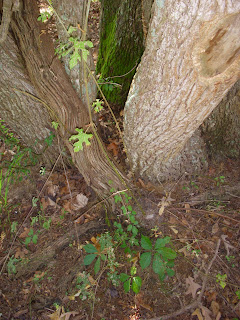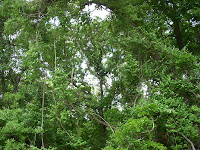This composite photo is from the same perspective as the photo that is the header for this blog. The lake is nearly gone.... only inches of water remain. Rapidly engulfing its edges are grasses of many descriptions. The ground is soft, indeed it will not support any significant weight - anything / person that tries to walk to water's edge will be consumed by the soft, water soaked mud. But 25 feet out, where the heat and sun has dried the earth, a trail exist. Made by feral hogs, deer and people frustrated that they cannot reach the water.
Sunday, September 4, 2011
Walk on the Trinity.....
We started early, picking our way to the banks of the River through a 'bottom land' full of towering oak. The trees of the river include sycamores, willows and oak... and many trees of yore - evidenced only by stubs, logs, piles of flotsam - from forests miles above.
We are amidst a remarkable drought in Texas, and the river is low. Allowing us to walk on the river bank next to the water for several miles.
The river is maligned in Texas - loosing notoriety to the Brazos and the Colorado -- but a walk reveals the natural beauty of the flow - and the many critters that rely on it.
We are amidst a remarkable drought in Texas, and the river is low. Allowing us to walk on the river bank next to the water for several miles.
The river is maligned in Texas - loosing notoriety to the Brazos and the Colorado -- but a walk reveals the natural beauty of the flow - and the many critters that rely on it.
Sunday, August 7, 2011
Drought Effects Summer of 2011
Amazing what a year will do. Heavy rains in June 2010 - with persistent rain thru that summer. Our lake looked great:
Today, in summer of 2011, we are entering our 37th day of greater than 100 degree temp - and essentially no significant precipitation for 2 months. The lake is down at least 3 feet..... It is amazing to see how rapidly vegetation 'consumes' the land made available by the receding water.
Saturday, June 12, 2010
Floods of June

In Mid June, East Texas had an intense storm roll thru. The storm began in Central Texas, causing remarkable flooding in New Braunfels, and closing the Guadelupe River due to flood damage. This storm gained strength & intensity thru East Texas - and moved into Arkansas, where it created the flash floods that engulfed a campground, killing scores.
As we walk thru our piece of wood, every 'low' area shows remarkable effects of the storm and 'flooding' that must have rushed thru the forest. Most remarkable is the way the water sweeped clean the forest floor.
Saturday, May 29, 2010
Smooth vine; liana
Saturday, May 22, 2010
Tendrils / Vines / Lianas


How do these vines develop to such size and crawl up these trees? This is a dramatic illustration. This tree sits in the middle of a field. It is engulfed by a mature vine. At the base of the tree the main vine trunk nearly looks like another portion of the main tree.
In all of our walks, it is hard to find 'young' vines. However, this vine had small, new shoots which emerge from the base of the main vine trunk. Close ups of the small slender shoot find tendrils - and the 'climb' begins.
Tendrils are often spring-like and cinch up a plant to the support by decreasing the overall length of the tendril. This coiling feature utilizes high friction for grasping structures. For vines, tendrils are a cheap way to climb, but a tendrilar system does not hold great weight. This mechanism is good for clinging during strong winds, and absorbs and dissipates energy. Development of tendrils is sylleptic and determinate.
Examples:
- long young tendrils are extended to find a support in a bignon
- in Marah macrocarpus can be seen here that a coiled tendril may be stretched
- in Tetrastigma voinierianum, young tendrils extended in search of support




Saturday, May 15, 2010
Subscribe to:
Comments (Atom)
















